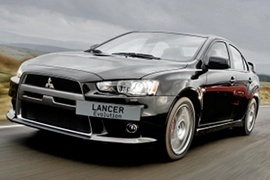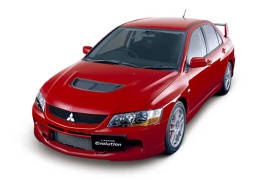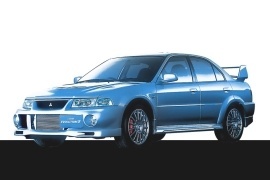
MITSUBISHI Lancer Evolution
Generations Timeline, Specs and Pictures

First launched under the form of two concept cars (Concept-X at the 39th edition of the Tokyo Motor Show and Prototype-X at the 2007 North American International Auto Show), the tenth generation Mitsubishi Lancer Evolution arrived in autumn 2007, with sales starting in the next few months.
Despite the fact that power of the new Lancer Evolution depend on their target market, each model develops at least 280 HP.
Apart from a sharper styling and a wide trapezoidal new grille, the 2008 Lancer Evolution X comes with a new 2-liter turbocharged engine mated to either a 5-speed manual or 6-speed sequential semi-automatic gearbox. The body gained more stiffness to aid with handling and reduce vibrations, while a wider track and longer wheelbase also help with the cause while offering more room for passengers.
In 2015, before the model’s extinction, Mitsubishi launched the Lancer Evolution X Final Edition, coming with an upgraded engine, new colors, special badging and a few interior enhancements.

The Mitsubishi Lancer Evolution IX was an enhanced version of its predecessor, the Evolution VIII.
It came with features that were fitted for a rally car, but able to be driven on the street.
The ninth evolution model of the Lancer was unveiled in Japan and at the Geneva Motor Show in 2005 on the same day. One month later, in April, it was shown at the New York International Auto Show. It featured almost the same specifications as the Evo VIII, but with some improvements over the engine and for the special MR edition.
The exterior of the car featured wide open in the front spoiler and the big intercooler for the turbo was exposed. On its sides, there were two fog-lights and another pair of cooling vents for the brakes. The black mesh-grille supported only the three-diamond chromed Mitsubishi logo. On the hood, there was an air-extraction vent that was not only for show. It was functional. On the rear side of the roof, Mitsubishi installed a line of small, shark-like, fins, which helped the aerodynamic. The rear massive spoiler on the trunk was fitted with an adjustment system, to help increase the downforce on the rear axle. While the MR featured special BBS light-alloy wheels, the rest of the lineup was fitted with a set of ENKEI wheels.
Inside, the Lancer featured sport-bucket seats and, for the MR edition, Recaro seats and Momo steering wheel. The instrument cluster featured four dials and a traction system indicator for the three settings available: tarmac, gravel, and snow.
Under the hood, there was the same 4G63 engine fitted on many Lance Evolution models, but for the IXth version, it was fitted with a variable valve timing named MIVEC. Apart from the MR version, which was fitted with a 6-speed manual, the rest of the trim levels had only 5-speed gearboxes. All models were all-wheel-drive.

The Evolution was redesigned again in 2003 with the new model having gained an improved traction control linked to a 6-speed manual transmission.
Available with the same 280 hp unit, the car came with a choice of three trims, the well known GSR and RS and a new MR. Among other new features, new Evos were equipped with an upgraded limited-slip differential and stylish Altezza tail lights. The MR in particular had lots of tweaks to differentiate it from the other equipment levels, including performance Bilstein shocks, an improved all wheel drive system and sporty anti-lock brakes. An aluminum roof and BBS alloy rims were also included in the MR package.

The dawn of the seventh generation Evo saw the coming of a larger car, based on the CT9A platform, the same the Mitsubishi Cedia had been built on.
To compensate the weight gain due to the switch do a new platform, engineers went as far as installing three differentials for optimum distribution of torque which also saw an increase to 385 Nm. Parallel bonnet air grills and several engine tweaks allowed better air flow and thus cooling for the power unit which had the same official output of 276 hp. A first for the Evo line-up was the introduction of an automatic transmission mated to a new trim level named the GT-A.

The sixth generation of the Lancer Evolution was more of a leap than a step ahead of its predecessor.
A new drivetrain made a big difference.
The World Rally Championship was at its heights in the late ’90s. Seven official factory teams gathered points for the final chart. Mitsubishi introduced the new car and it ended in fourth place. But it was six times on the podium and had a victory in the inaugural race, at Monte Carlo. The new Lancer Evolution WRC was based on the EVO VI model. It was rough, hard to control, and with new technologies that were difficult to understand by the drivers.
From the outside, the outrageous looking hood with extracting air-vents, the huge and flat apron for the intercooler, and the straight-cut headlights give the others a clue about what lies under the car. The big adjustable wing in the back was fully functional, adding aerodynamic load at high speeds.
Inside, the base model was basic. The cheapest seats, no AC, no radio, no power windows, and available only with steel wheels and white. It was built for private rally teams from around the world. The top trim levels offered Recaro sport-bucket seats and all the comfort for a quick car. The special TME (Tommi Makinen Editon) featured a special painting scheme, that mimicked the rally car.
The Lancer Evo VI was fitted with a 2.0-liter engine that offered, officially, 280 hp. It was mated to a 5-speed manual. The all-wheel-drive system featured a limited-slip differential in the back and an intelligent center differential. That was the biggest difference when compared to the Evo V. And, of course, nobody believed that a 280 hp sedan could get a 0-100 kph (0-62 mph) in 4.4 seconds.

Coerced by the newly introduced WRC regulations, Mitsubishi released the firth generation Evo in 1998.
The car saw many changes from body styling to performance oriented under-bonnet adjustments. While the engine was upgraded having been mated to a new turbocharger, power output was limited to the previously achieved 276 hp as part of a “gentleman’s agreement” that said power had to be capped at the max value of 280 hp. However, torque was increased in the process from 352 NM to 373 Nm while braking was improved through the addition of Brembo brake on wheels that saw a growth from 16 ” to 17 “

The Lancer Evolution IV was a true milestone in the rally-race inspired cars from Mitsubishi.
It was launched in 1996 and it was the first to introduce the Active Yaw Control, which made the car faster on the bends.
The Lancer Evo IV was launched in two versions: the RS and the GSR. The RS was the base model to be transformed as a rally car. It was white, with the cheapest seats in the house and bare steel wheels. It was just easy to buy and to transform. It featured all the important technology included. The GSR version was the road-going model, with more comfort options, alloy wheels, and a better interior.
The Lancer Evo IV had a fierce look on the road, to match its performances. It featured big fog lights, a sculptured hood, and big air intakes in the front bumper. A massive wing was installed in the back. Also, there was a specific design for the taillights, which became a signature for the future Evo models.
Inside, the GSR featured race-bucket seats and better equipment, such as air-conditioning or power windows. For some countries, it was available with a sunroof.
The technology underneath the skin was impressive. The 2.0-liter turbocharged gasoline engine, named 4G63, featured a larger intercooler than its predecessor and offered more power. The all-wheel-drive system was equipped with an active center differential, named Active Yaw Control that could distribute the torque between the front and rear wheels. A limited-slip rear differential was available on the options list. A 5-speed manual was the only transmission offered.

The third generation Lancer cemented Mitsubishi’s certainty of having struck gold.
Having been produced in more units than any of the previously released models, the Evo III saw a series of cosmetic changes that were also intended to boost the cars performance, ie the new nose designed to better drive air to the car’s underpinnings. Due to lift force on previous models, the car’s rear wing was increased to reduce the effect while new side skirts and corners were added. The engine was replaced with a new turbocharged unit that was mated to an intercooler, increasing power output by 10 hp. As in Evo II’s case, torque remained the same.

Having entered a new evolution stage, the Mitsubishi Evo saw a few changes mainly aimed at its underpinnings.
While the body shell remained virtually unchanged with only a few tweaks such as wider tires and a larger spoiler having been made, the car’s “innards” received several upgrades. Suspension and stability were improved through the addition of larger swaybars while the engine, the same as the one form the first Evo, received a greater output of 252 hp compared to the previous (244 hp). Despite the hp increase, torque was not boosted for any of the two models.

Part of the Japanese manufacturer’s efforts to deliver a competitive racing vehicle in the WRC, the first generation Evolution was launched in 1992.
Setting a standard for all future versions, the first Evo came with a choice of 2.0 L turbocharged double overhead camshaft engine mated to a performance 4-wheel drive system, both elements having been sourced from the previously released VR-4. Available in GSR and RS trims, the car was either a well equipped vehicle with an output of 144 hp in GSR’s case or street racing version lacking features like ABS and power seats/windows in the latter’s case.























































